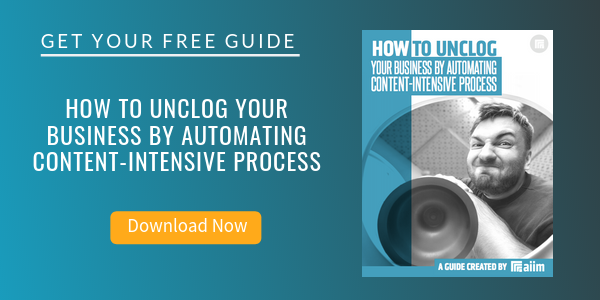
5 Considerations for Modern Human Capital Management (HCM)
Enterprise Resource Planning (ERP) | Enterprise Content Management (ECM)
Are your Human Resources processes intelligent? Before you try and answer that, let me explain more about what I mean.
This idea of intelligent processes stems from an evolving set of capabilities that transform the way we manage information into something smarter and more connected than ever before. AIIM calls this Intelligent Information Management - and we believe it has the power to revamp your business processes, including Human Capital Management (HCM).
So, now come back to my initial question - how do you tell if your HR processes are intelligent and connected? Here are five key issues you need to consider when thinking about Human Capital Management. Think of it as an IQ test of sorts for your processes.
1. Human Capital Management is not actually one process, but a series of connected processes with overlapping information requirements.
The best way to think about HR process automation is by thinking about it over the lifecycle of an employment relationship and the kinds of documents that are typical in each stage of the life cycle. (For illustration, the compliance documents listed below are for the U.S. These obviously vary by country, making it even more important to standardize and automate wherever possible.)
- Recruitment and Onboarding (resumes, interviews, offer letters, job description, I-9 forms, references)
- Payroll and Compensation (incentive plan documentation, W-2 forms, garnishments, leave documentation)
- Benefits (plan documentation, beneficiaries, dependents, Family and Medical Leave Act documentation)
- Performance Management (reviews, disciplinary actions, promotions)
- Learning and Development (certifications, training)
- Separation or Retirement (resignation and separation letters, COBRA, vacation payouts)
There is a high degree of manual work in each of these processes. 63% of organizations say that HR processes are less than 50% automated. 50% of organizations say that managing unstructured information is a huge challenge in automating HR processes. (AIIM, 2018, Enhancing Your RPA Implementation with Intelligent Information)
2. HR processes are high value and high risk.
Communications and agreements through the life of an employee’s time with an organization are high value -- they shape the very nature of the employment relationship. This begins with the first impression a potential employee gets during the recruitment process and continues all the way through to communications after the employment relationship ends. Managing employee information via paper documents and in unorganized file shares leads to inefficient and error-prone HR processes -- and the potential for lots of frustration for both employees and HR executives. Employees expect proactive, personalized, and transparent HR communications and processes -- and a minimum of time-wasting manual processes.
HR processes are also high risk. Organizations must be able to access global employee records quickly. To mitigate legal risks, the storage, auditing, and management of all employee information must meet local, national and industry compliance standards. The key consideration in building auditable and accountable HR processes is automation and standardization of core document processes. This begins with a consistent process for how HR documents are generated, carries through to how these documents are actively managed, how they are made available to employees, and ultimately which documents become long-term records.
3. The strategy for managing employee information needs to seamlessly integrate with the multiple systems used to manage HR processes.
Organizations at large scale have a long history of process-specific information silos that hinder their ability to manage and optimize across processes. Part of the challenge is that it has been difficult to integrate information capabilities into key enterprise processes, and HR is no exception. This problem becomes even more acute as line-of-business executives, frustrated with the pace of centralized IT innovation, adopt SaaS (Software as a Service) solutions to ease their immediate process pain.
AIIM research suggests that 55% of the unstructured content and information needed to fuel key line-of business systems (ERP, HR, Finance, CRM, Project Management, LOB, etc.) is “siloed” within those systems INSTEAD OF in a Content Management system(s). The reason for this is that integration historically has been just too difficult in monolithic ECM systems; the drive toward content services is a reaction to this. 70% of organizations say they “want to pick only the information capabilities we need for each process or application.” (AIIM, 2018, The State of IIM: Getting Ahead of the Digital Transformation Curve)
4. The impact of HR processes extends well beyond HR.
Users across the organization need to access HR information to do their jobs. For example, an HR business partner who is responsible for employee administration and the day to day management of employee documents needs to find all documents associated with an employee, ensure all documents for an employee are up to date, quickly respond to an audit request, and ensure all documents have been identified in the case of a legal hold. In most organizations this these are very manual, time consuming processes, prone to error as they need to go search each solution for employee documents.
This becomes exponentially more complex when you think about other roles across the organization such as: 1) shared services; 2) a compliance officer looking to meet regulatory requirements; 3) a records manager looking to preserve employee records; 4) a compliance or security officer looking to securely control document access and protect employee privacy; or 5) a manager who is looking to access some employee documents. The problem in most organizations is that there is no single point of access to HR documents.
5. Human Capital Management is really about finding and retaining the best talent.
The next frontier in HR Management is mining all of the accumulated information associated with HR processes to determine how and where to find the best employees, and how to best retain them. Per Josh Bersin in Forbes, “The old-fashioned fuddyduddy HR department is changing. The geeks have arrived...After years of talking about the opportunity to apply data to people decisions, companies are now stepping up and making the investment. And more exciting than that, the serious math and data people are flocking to HR.”
The concept of “people analytics” represents a new way of thinking about traditional problems like recruiting, training, retention, and promotion that was impossible in the days of incompatible and siloed systems. Of course, none of this is possible unless the unstructured information (i.e., content and documents) that surrounds HR processes can be first turned into machine-comprehensible structured data.
Conclusion
So what kinds of Intelligent Information Management capabilities should you look for in addressing these five issues? You should look for solutions that do some or all of the following:
- Digitize and manage employee documents in the cloud
- Link employee files to employee data in the lead HR System(s)
- Ensure access to employee documents is secure and audited
- Multi-channel document generation and distribution
- Provide 360-degree view of employee documents and interactions
- Provide self-service access for employees
- Guarantee document retention and disposition
- Monitor employee files for compliance
- Improved process efficiencies
About John Mancini
John Mancini is the President of Content Results, LLC and the Past President of AIIM. He is a well-known author, speaker, and advisor on information management, digital transformation and intelligent automation. John is a frequent keynote speaker and author of more than 30 eBooks on a variety of topics. He can be found on Twitter, LinkedIn and Facebook as jmancini77. Recent keynote topics include: The Stairway to Digital Transformation Navigating Disruptive Waters — 4 Things You Need to Know to Build Your Digital Transformation Strategy Getting Ahead of the Digital Transformation Curve Viewing Information Management Through a New Lens Digital Disruption: 6 Strategies to Avoid Being “Blockbustered” Specialties: Keynote speaker and writer on AI, RPA, intelligent Information Management, Intelligent Automation and Digital Transformation. Consensus-building with Boards to create strategic focus, action, and accountability. Extensive public speaking and public relations work Conversant and experienced in major technology issues and trends. Expert on inbound and content marketing, particularly in an association environment and on the Hubspot platform. John is a Phi Beta Kappa graduate of the College of William and Mary, and holds an M.A. in Public Policy from the Woodrow Wilson School at Princeton University.



